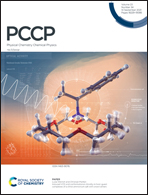Surface amplification of tetraphenylporphyrin overtone and combination Raman bands in drop coating deposition Raman (DCDR) on electrically conductive surfaces†
Abstract
It is essential to realize a Raman measurement technique without artifact or fluorescence signals for high-quality and reliable data in a valid molecular-level analysis and interpretation. This requirement applies especially to a molecule with strong fluorescence like porphyrin. Here, the surface of a gold substrate performs better as a DCDR substrate for tetraphenylporphyrin than other surfaces, such as tantalum, indium tin oxide glass, or aluminium. Polarized Raman spectra of tetraphenylporphyrin demonstrated the oriented deposition of porphyrin crystallites on the Au substrate using the drop coating technique. The emission anisotropy suggests that the deposited crystallites are arranged outward radially with the porphyrin ring orientation. The orientation is signed by the NH⋯HN axis that is parallel to the radial vector along the X-axis. Moreover, it also demonstrates high chemical stability after preservation and repeated measurements. The Raman signal on a gold substrate is enhanced more than on other substrates beyond mere preconcentration of analytes or the coffee-ring effect only, which might be due to the contribution of the SERRS effect. This effect will be discussed based on the interactions among localized surface plasmons, vibronic transitions, and Raman active vibrational modes.



 Please wait while we load your content...
Please wait while we load your content...